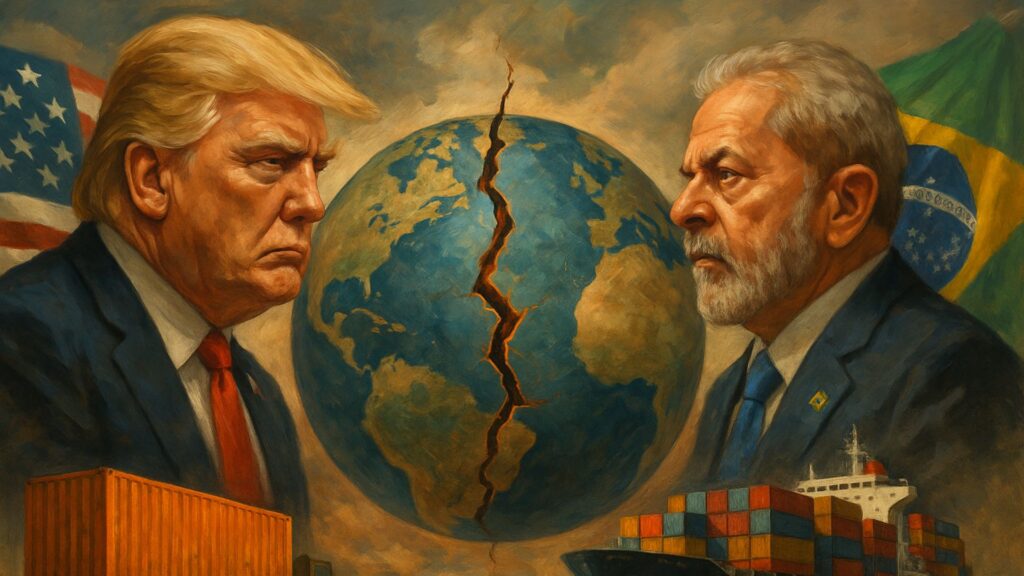The US–Brazil trade relationship has taken a sharp turn following President Donald Trump’s latest move: a 50% tariff on Brazilian imports, set to begin on August 1.
Citing claims of a trade deficit and perceived attacks on American free speech, Trump issued a strongly worded statement directed at President Luiz Inácio Lula da Silva’s government.
But the response from Brasília was swift, measured, and confident. Lula dismissed the threats, arguing that US trade accounts for a mere fraction of Brazil’s GDP and that his country is more than capable of managing without Washington’s approval.
This diplomatic flare-up, though heated in tone, might not carry the economic consequences Trump imagines.
Trump’s Tariff Plan: Political Motives Disguised as Economic Policy?
Donald Trump’s announcement of a 50% tariff on all Brazilian goods came with more than just economic grievances.
On the surface, the justification was a trade deficit, a claim that has been flatly denied by Brazil, which notes that the US has enjoyed a $410 billion surplus over the past 15 years. However, the real motivation appears more political than fiscal.
In his Truth Social posts, Trump accused Brazil of undermining American free speech, specifically referencing censorship orders handed down by Brazil’s Supreme Court against US-based social media platforms.
He also criticised the country’s treatment of former President Jair Bolsonaro, who is under investigation for his role in an alleged coup plot. Calling it a “Witch Hunt,” Trump appeared to defend Bolsonaro while blaming Lula’s administration for suppressing political dissent.
This is not an isolated action. Brazil was only one of several nations targeted in a new wave of tariffs, as part of what Trump describes as a strategy to push trade partners into renegotiating terms.
Letters announcing tariff hikes were sent to over 20 countries in a single day. Yet Brazil’s case stands out due to its scale and the political overtones that accompanied it.
Vice President Geraldo Alckmin quickly dismissed Trump’s claims, calling the tariff “inappropriate” and unjustified.
He pointed to America’s consistent trade surplus with Brazil and warned that imposing such tariffs could end up hurting US industries, particularly steel production, which relies on semi-finished Brazilian goods for processing.
The move also appears to be testing legal boundaries. Trump’s team has invoked the International Emergency Economic Powers Act (IEEPA) as the basis for his decision.
The legality of using IEEPA in this context is now being challenged in court, with several US senators describing the tariff as “job-killing” and “an abuse of power.” With the White House already facing legal scrutiny, the policy risks being as ineffective as it is provocative.
Brazil’s Calm Defiance: A Shrug, Not a Panic
While markets initially reacted to the announcement, Brazil’s currency fell 2.3% and stock futures dipped, the government’s response has been composed and assertive.
President Lula, in a televised interview, reiterated that US trade makes up just 1.7% of Brazil’s GDP. He stressed that Brazil would seek other partners and that the country’s sovereignty would not be compromised.
Lula’s remarks were not just defensive. They reflected a wider geopolitical posture that Brazil has been adopting in recent years. Speaking at the BRICS summit in Rio de Janeiro, he called for a global move away from dependence on the US dollar in international trade.
This aligns with the bloc’s broader ambition to reshape the global financial landscape. Trump’s latest threats, rather than weakening Brazil’s resolve, may only accelerate this pivot.
From a policy standpoint, Lula and his ministers have highlighted Brazil’s trade law, which allows for reciprocal action.
While no countermeasures have been confirmed yet, officials have hinted at the possibility. For now, Brazil seems more interested in watching the US manage its own internal backlash than rushing into a retaliatory trade war.
Alckmin, speaking from Brasília, warned that any increase in tariffs could ultimately hurt American buyers more than Brazilian exporters.
He pointed to Brazil’s strategic role in supplying coal used for US steel manufacturing. Adding costs to this supply chain, he suggested, would be self-defeating.
The Brazilian administration’s response reveals a level of confidence not often seen in countries targeted by Washington’s trade policies.
Rather than entering a cycle of panic and concessions, Brazil appears to be calculating its options, keeping the door open for diplomacy while standing firm on its economic independence.
Conclusion
Trump’s tariff threat on Brazilian goods has generated headlines, but its real-world impact remains uncertain.
With the rationale under legal dispute, and the economic justification refuted by Brazil, the move appears more symbolic than strategic. For Brazil, the response has been measured and clear, which is that the country is not intimidated and will pursue alternative trade paths if necessary.
If anything, Trump’s announcement may have strengthened Brazil’s resolve to reduce its reliance on the United States and align more closely with emerging global powers. In the end, it seems the one truly rattled by this standoff is not Brasília, but Washington.

